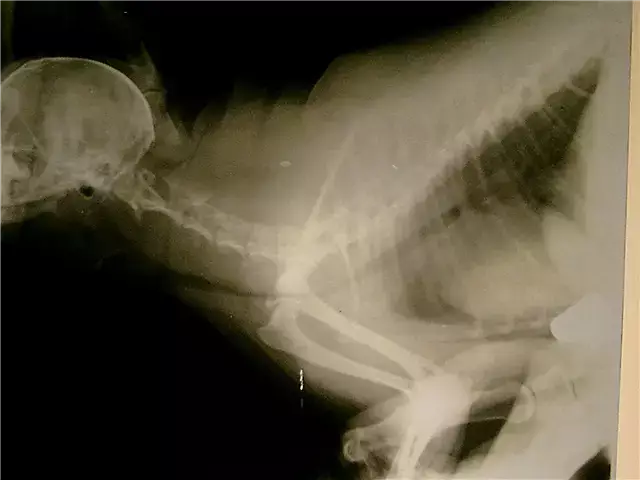- Author Rachel Wainwright [email protected].
- Public 2023-12-15 07:39.
- Last modified 2025-11-02 20:14.
E-tea
Instructions for use:
- 1. Release form and composition
- 2. Properties of components
- 3. Indications for use
- 4. Contraindications
- 5. Recommendations for use
- 6. Special instructions
- 7. Terms and conditions of storage

E-tea is a biologically active food supplement (BAA), an additional source of flavonoids, containing tannins.
Release form and composition
BAA E-tea is produced in the form of capsules weighing 434 mg (100 pcs. In polymer bottles).
1 capsule contains:
- active ingredients: common sorrel herb (Rumex acetosella) - 49.2 mg; burdock root (Arctium lappa) - 64.7 mg; rhubarb root (Rheum officinale) - 3 mg; rusty elm bark (Ulmus rubra) - 12 mg;
- auxiliary ingredients: silicon dioxide, rice oligodextrin, gelatin.
Component properties
Four herbal ingredients, uniquely processed to preserve their natural effects and encapsulated in a capsule, have the following properties:
- Arctium lappa (burdock, burdock, burdock): in folk medicine, it is taken orally to treat rheumatism and gout, used externally for skin diseases (acne, furunculosis, eczema), wounds, cuts, burns, abrasions, inflammation and swelling of the skin. Preparations based on it have a diuretic, analgesic, choleretic, antiallergic and disinfectant effect; decoctions of burdock root and burdock oil (infusion of the root in olive or peach oil) treat skin diseases and strengthen hair in case of baldness; infusions of leaves are taken in case of impaired kidney and gallbladder function, constipation, joint pain, diabetes mellitus; fresh leaves are used as an antipyretic agent, for mastopathy, rheumatism, for wound healing; burdock alkaloids (arktigenin) have antitumor activity,and young leaves - antibacterial action;
- Rumex acetosella (passerine sorrel, sour sorrel, common sorrel, hare sorrel, etc.): has a diaphoretic, antiseptic, diuretic effect; the plant is used for hemorrhoids, diarrhea, dysentery, tuberculosis, renal failure, diseases of the urinary tract, dysuria; the herb infusion has an astringent, choleretic, anti-inflammatory effect, it is taken for headaches, fever, uterine bleeding, liver dysfunction;
- Ulmus rubra (red or rusty elm, elm): strong astringent, diuretic, anti-inflammatory, wound healing, antitussive effect; used to treat fever, renal and hepatic colic, joint pain, pneumonia, gastrointestinal tract, urinary tract; the plant is also eaten, since porridge made from the inner part of the elm bark is not inferior in calorie content to oatmeal;
- Rheum officinale (medicinal rhubarb): the root of the plant has a strong tonic and antibacterial effect, the anthraglycosides contained in it are an intense laxative, chrysophanic acid has a mild laxative effect, and tannoglycosides have an astringent effect; Medicines based on rhubarb roots are widely used to treat various digestive disorders; rhubarb is mainly taken in high doses for habitual constipation, hemorrhoids, intestinal atony (sluggish peristalsis), and abundant gas as a laxative.
Thanks to the specially selected composition, E-tea is used as a means:
- normalizing the function of the digestive system;
- detoxifying and antioxidant;
- anti-inflammatory, antitumor, wound healing, antiseptic;
- lowering cholesterol levels;
- strengthening the immune system.
Indications for use
E-tea is recommended as a bioactive food supplement - an additional source of flavonoids and tannins - for the following diseases / conditions:
- oncological diseases (for the purpose of prevention or as part of complex therapy);
- colds, cough;
- inflammatory processes of the digestive and urinary systems;
- hemorrhoids and constipation;
- diabetes;
- rheumatism.
Contraindications
- pregnancy and lactation (lactation);
- individual hypersensitivity to any component of the product.
Recommendations for use
The capsules are taken orally.
Recommended dosage: for adult patients, 2 capsules 3 times a day. Capsules should be taken with meals, but on the recommendation of a specialist, it is possible to take the drug on an empty stomach, half an hour before meals.
The course is 5-7 days, if necessary, it is possible to re-admit it.
special instructions
E-tea is not a drug. Before using dietary supplements, it is recommended to consult a doctor.
Terms and conditions of storage
Store in a dry place out of the reach of children, at a temperature not exceeding 25 ° C.
The shelf life is 3 years.

Maria Kulkes Medical journalist About the author
Education: First Moscow State Medical University named after I. M. Sechenov, specialty "General Medicine".
Information about the drug is generalized, provided for informational purposes only and does not replace the official instructions. Self-medication is hazardous to health!






